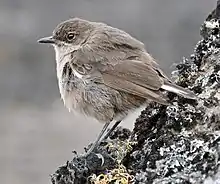Moorland chat
The moorland chat (Pinarochroa sordida), also known as the alpine chat or hill chat, is a species of songbird in the Old World flycatcher family. It is endemic to north-east Africa where it is common in its habitat. It lives at high altitudes on moors and grassland, usually above 3,400 m (11,100 ft), but can live as low as 2,100 m (6,900 ft).[2] It has a short tail and long legs. It is bold and will approach people.
| Moorland chat | |
|---|---|
_composite.jpg.webp) | |
| C. s. sordida, Ethiopia | |
 | |
| P. s. ernesti, Kenya | |
| Scientific classification | |
| Domain: | Eukaryota |
| Kingdom: | Animalia |
| Phylum: | Chordata |
| Clade: | Dinosauria |
| Class: | Aves |
| Order: | Passeriformes |
| Family: | Muscicapidae |
| Genus: | Pinarochroa Sundevall, 1872 |
| Species: | P. sordida |
| Binomial name | |
| Pinarochroa sordida (Rüppell, 1837) | |
| Synonyms | |
|
Cercomela sordida | |
Taxonomy
The moorland chat was formally described in 1837 by the German naturalist Eduard Rüppell from a specimen collected in the Simien Mountains of northern Ethiopia. Rüppell coined the binomial name Saxicola sordica.[3][4]
The chat was discovered on Mount Elgon on the Uganda-Kenya border by Frederick Jackson. The English geographer Halford Mackinder brought back the same bird from Mount Kenya in 1899.[5] He presented a paper on the first ascent to the Royal Geographical Society in 1900. The scientific results of his expedition were discussed in detail afterwards.
A very curious little bird was found by Mr Jackson on Mount Elgon at a height of 11,000 feet, and I remember saying to Mr. Mackinder that he was bound to find the same sort of little chat on Mount Kenya, at a height of 11,000 feet. This he did, and it was the same species as the Mount Elgon bird, an ordinary-looking little brown chat, with a good deal of white in the tail.
— Dr Bowdler Sharpe, A Journey to the Summit of Mount Kenya, British East Africa: Discussion[5]
The moorland chat was usually placed in the genus Cercomela, but molecular phylogenetic studies published in 2010 and 2012 found that the species was not closely related to birds in Cercomela or to birds in the closely related genus Oenanthe.[6][7] The moorland chat was therefore assigned to its own monotypic genus Pinarochroa which had been introduced by the Swedish zoologist Carl Jakob Sundevall in 1872.[8][9][10] The genus name Pinarochroa is derived from the Greek word pinaros meaning "dirty" and khroos, khroas meaning "coloured". The specific epithet sordida is from the Latin sordidus meaning "shabby" or "dirty".[11]
Four subspecies are recognised:[8]
- P. s. sordida (Rüppell, 1837) – Ethiopia
- P. s. ernesti Sharpe, 1900 – Uganda and Kenya[12]
- P. s. olimotiensis Elliott, HFI, 1945 – Crater Highlands (north Tanzania)
- P. s. hypospodia Shelley, 1885 – Mount Kilimanjaro (north Tanzania)
References
- BirdLife International (2016). "Pinarochroa sordida". IUCN Red List of Threatened Species. 2016: e.T22710389A94244854. doi:10.2305/IUCN.UK.2016-3.RLTS.T22710389A94244854.en. Retrieved 12 November 2021.
- Birds of Africa south of the Sahara, Ian Sinclair and Peter Ryan (2003) Struik ISBN 1-86872-857-9
- Rüppell, Eduard (1835). Neue Wirbelthiere zu der Fauna von Abyssinien gehörig (in German). Vol. Vögel. Frankfurt am Main: S. Schmerber. p. 75, Plate 26, Fig. 2. The volume is dated 1835 on the title page but it was published in sections and the section containing page 75 was published in 1837. See: Dickinson, E.C.; Overstreet, L.K.; Dowsett, R.J.; Bruce, M.D. (2011). Priority! The Dating of Scientific Names in Ornithology: a Directory to the literature and its reviewers. Northampton, UK: Aves Press. p. 139. ISBN 978-0-9568611-1-5.
- Mayr, Ernst; Paynter, Raymond A. Jr, eds. (1964). Check-List of Birds of the World. Vol. 10. Cambridge, Massachusetts: Museum of Comparative Zoology. p. 103.
- Mackinder, H.J.; et al. (1900). "A journey to the summit of Mount Kenya, British East Africa: Discussion". The Geographical Journal. 15 (5): 453–486 [479]. doi:10.2307/1774261. JSTOR 1774261.
- Outlaw, R.K.; Voelker, G.; Bowie, R.C.K. (2010). "Shall we chat? Evolutionary relationships in the genus Cercomela (Muscicapidae) and its relation to Oenanthe reveals extensive polyphyly among chats distributed in Africa, India and the Palearctic". Molecular Phylogenetics and Evolution. 55 (1): 284–292. doi:10.1016/j.ympev.2009.09.023. PMID 19772925.
- Aliabadian, M.; Kaboli, M.; Förschler, M.I.; Nijman, V.; Chamani, A.; Tillier, A.; Prodon, R.; Pasquet, E.; Ericson, P.G.P.; Zuccon, D. (2012). "Convergent evolution of morphological and ecological traits in the open-habitat chat complex (Aves, Muscicapidae: Saxicolinae)". Molecular Phylogenetics and Evolution. 65 (1): 35–45. doi:10.1016/j.ympev.2012.05.011. PMID 22634240.
- Gill, Frank; Donsker, David; Rasmussen, Pamela, eds. (July 2023). "Chats, Old World flycatchers". IOC World Bird List Version 13.2. International Ornithologists' Union. Retrieved 22 July 2023.
- Clement, Peter; Rose, Chris (2015). Helm Identification Guides: Robins and Chats. London: Christopher Helm. p. 632. ISBN 978-1-4081-5597-4.
- Sundevall, Carl Jakob (1872). Methodi naturalis avium disponendarum tentamen: försök till fogelklassens naturenliga uppställnung (in Swedish, French, and Latin). Vol. 1. Stockholm: Samson & Wallin. p. 4.
- Jobling, James A. (2010). The Helm Dictionary of Scientific Bird Names. London: Christopher Helm. pp. 307, 360. ISBN 978-1-4081-2501-4.
- Sharpe, R. Bowdler (1900). "Dr. Bowdler Sharpe described the following species from the Mackinder expedition to Mt. Kenya". Bulletin of the British Ornithologists' Club. 10: 35–36 [36].
